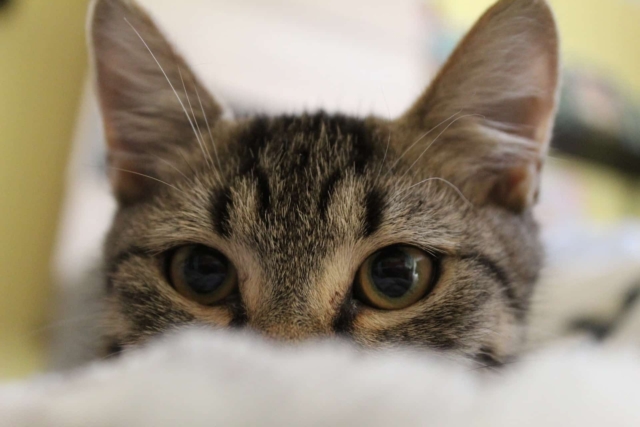
Cats, beloved companions to many, have a reputation for being easily spooked. Sudden noises, unfamiliar people, or even a change in their environment can send them running for cover. But what exactly causes these feline frights? Understanding the common triggers for cat fear can help us create a safer and more comfortable environment for our furry friends.
One of the most common triggers for cat fear is loud noises. Cats have incredibly sensitive hearing, so sounds that may seem harmless to us can be overwhelming to them. Thunderstorms, fireworks, or even a dropped object can startle a cat and trigger their fear response. Additionally, unfamiliar people or animals can also cause cats to become fearful. Cats are territorial creatures, and the presence of a stranger in their space can be perceived as a threat.
The Evolutionary Explanation for Cats’ Easily Spooked Nature
To truly grasp why cats are easily spooked, we must delve into their evolutionary history. Cats are natural predators, and their survival instincts are finely honed. Their ancestors, such as wildcats, needed to be hyper-vigilant to stay alive in their natural habitats. Any unexpected noise or movement could potentially be a threat or a source of prey. This innate fear response has been passed down through generations, leading to the easily spooked nature we observe in domestic cats today.
The Role of Genetics in Cat Fearfulness
Genetics also play a significant role in a cat’s fearfulness. Certain breeds, such as Siamese or Oriental Shorthair, are more prone to being easily spooked. This predisposition can be attributed to specific genetic traits that make these cats more sensitive to their surroundings. However, it’s important to note that not all cats of these breeds will exhibit fearfulness, as environmental factors also contribute to a cat’s overall temperament.
In addition to breed-related genetic factors, individual genetics also influence a cat’s fear response. Just like humans, cats have unique personalities and temperaments. Some cats may have a genetic predisposition to being more anxious or easily frightened, while others may be more confident and resilient. Understanding your cat’s genetic makeup can help you tailor your approach in reducing their fear and anxiety.
The Impact of Past Experiences on a Cat’s Fear Response
Past experiences can have a profound impact on a cat’s fear response. Cats that have had negative encounters or traumatic events in the past may develop a heightened fear response to similar situations. For example, a cat that has been attacked by a dog may become fearful and anxious whenever they encounter a canine. These past experiences create lasting impressions on a cat’s psyche, making it crucial for us to be mindful of their history and provide a safe and secure environment.
It’s important to note that even seemingly minor incidents can leave a lasting impact on a cat’s fear response. A loud argument, a fall from a height, or even a sudden move can trigger fear and anxiety in a cat. As responsible cat owners, it is our duty to create a nurturing environment that minimizes the likelihood of traumatic experiences and promotes a sense of safety and security.
Signs That Your Cat Is Scared or Anxious
Cats, like humans, express their emotions through various signals and behaviors. It’s essential to recognize the signs that your cat is scared or anxious so that you can address their needs appropriately. Some common signs of fear in cats include:
- Hiding: When a cat is scared, they may seek out hiding spots where they feel safe and protected. This could be under furniture, in closets, or even behind curtains.
- Excessive grooming: Cats may resort to excessive grooming as a way to self-soothe when they are anxious or frightened. Pay attention to any changes in their grooming habits, such as increased licking or the development of bald patches.
- Avoidance: Cats may actively avoid situations, people, or places that trigger their fear response. They may retreat to a secluded area or refuse to interact with certain individuals.
- Changes in body language: A scared or anxious cat may exhibit certain body language cues, such as flattened ears, dilated pupils, a lowered body posture, or a bushy tail. These physical signs indicate that the cat is feeling threatened or fearful.
By being observant and attuned to your cat’s behavior, you can identify when they are feeling scared or anxious and take appropriate steps to alleviate their fears.
Techniques for Helping a Scared Cat Feel Safe and Secure
If your cat tends to get easily spooked, there are several techniques you can employ to help them feel safe and secure in their environment.
- Create safe spaces: Provide your cat with designated safe spaces where they can retreat to when they feel scared or anxious. These spaces can be in the form of cozy cat beds, enclosed hideaways, or even a dedicated room where they can have some quiet time.
- Slowly introduce new experiences: If your cat is fearful of new experiences or unfamiliar people, introduce them gradually in a controlled manner. Use positive reinforcement techniques, such as treats or playtime, to associate these new experiences with something positive.
- Establish routine and predictability: Cats thrive on routine and predictability. By establishing a consistent daily routine, feeding schedule, and playtime, you can create a sense of stability for your cat. This predictability can help reduce their anxiety and make them feel more secure.
Creating a Calm Environment for Your Cat
Creating a calm environment is crucial for helping a scared cat feel at ease. Here are some tips to create a peaceful atmosphere:
- Reduce loud noises: Minimize loud noises in your home, especially during times when your cat is most active or likely to be startled. Use sound-dampening techniques, such as closing windows, playing soft music, or using white noise machines.
- Provide hiding spots: Ensure that your cat has access to hiding spots throughout your home. These can be in the form of cat trees, shelves, or even cardboard boxes with cozy blankets inside. These hiding spots provide a sense of security for your cat.
- Use pheromone products: Consider using pheromone products, such as sprays or diffusers, which release calming pheromones that mimic a mother cat’s scent. These products can help reduce stress and anxiety in cats.
The Importance of Positive Reinforcement in Reducing Fear in Cats
Positive reinforcement is a powerful tool in reducing fear and anxiety in cats. By rewarding desired behaviors with treats, praise, or playtime, you can help your cat associate positive experiences with situations that previously caused fear. This process is known as counter-conditioning.
For example, if your cat is fearful of loud noises, you can start by playing a low volume recording of the noise while offering treats or engaging in play. Gradually increase the volume over time, always rewarding your cat for their calm behavior. This gradual exposure and positive reinforcement can help your cat overcome their fear and build confidence.
Working with a Professional to Address Your Cat’s Fear Issues
In some cases, a cat’s fear issues may be more severe or deeply ingrained, requiring professional assistance. If your cat’s fearfulness is significantly impacting their quality of life, it’s recommended to seek the help of a veterinarian or a certified animal behaviorist.
These professionals can conduct a thorough assessment of your cat’s behavior, provide expert guidance, and develop a customized behavior modification plan to address your cat’s fear issues. With their expertise and support, you can help your scaredy-cat overcome their fears and live a happier, more confident life.
Understanding and Supporting Your Scaredy-Cat
Cats’ easily spooked nature is a combination of evolutionary instincts, genetics, and past experiences. By understanding the common triggers for cat fear and implementing techniques to help them feel safe and secure, you can create a nurturing environment that supports your scaredy-cat.
Remember to be patient and consistent in your approach, using positive reinforcement to build your cat’s confidence. And if needed, don’t hesitate to seek professional help. With your love and support, your cat can overcome their fears and thrive in a world that may be scary but can also be filled with comfort and happiness.
If you’re struggling with your cat’s fearfulness and need professional guidance, reach out to a veterinarian or certified animal behaviorist today. Your scaredy-cat deserves a life free from fear and anxiety.
If you enjoyed my article, I would appreciate you sharing it with your network.

Sima Ndlebe
Sima writes for CatBuzz. He is interested in Cats, Health and Fitness, and Entrepreneurship.
Published: 16 November 2023




